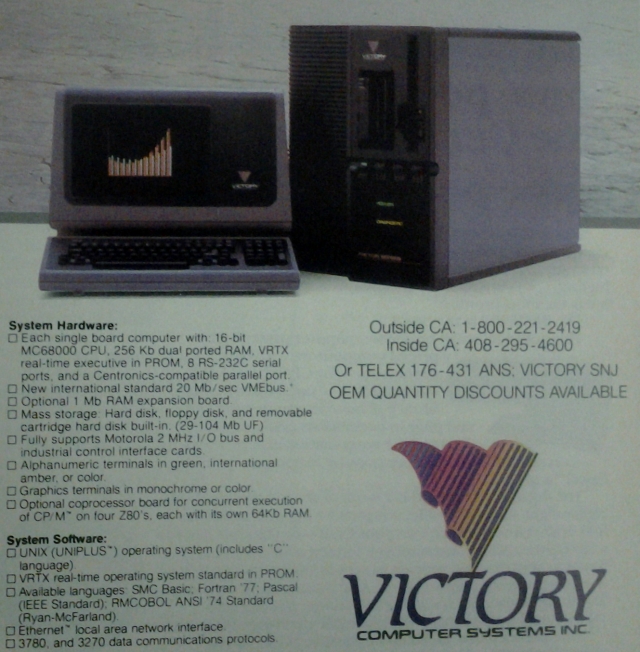I was the chief software engineer for Victory Computer Systems at the time. Allow me to clarify

- Roger Vass was CEO and founder of VCS, having been a cofounder and marketing VP of Altos Computer Systems.
- The Victory Spirit never came about because, at that time, the 186 chips were on allocation and Intel wouldn't give them out unless you also took in their DRAM chips.
- Although brochures may have listed smaller RAM configurations, all units shipped with at least 1MB of RAM.
- Victory had a short lived desktop chassis (think early PC type chassis with a monitor on top).
- Not shown, Victory also had a "Micro Factor" tower chassis. Slimmer and taller than the Factor, it was about the same size as a typical tall desktop design today.
The Factor/MicroFactor hardware:
- Central bus was VME and all Victory cards were the double height (400 mm?) sizes
- MMU was a segmented architecture with 4K pages (similar to early Sun 68k designs)
- From 1MB to 4MB of DRAM
- an intelligent/smart disk controller based on a Z8000 cpu that supported up to four hard drives (from 40MB to 200MB each), a 25MB streaming tape backup (in lieu, of the 5MB cartridge disk backup shown above), and 8" and/or 5-1/4" floppies. The hard drives were originally 40MB 8" drives and later became 5-1/4". The 8" drives were "overclocked" to 5Mhz to provide extra capacity and faster throughput.
- 8 port intelligent serial multiplexor based on a z80. This allowed the Factor to run all 8 ports at a full 19200 baud, bidirectionally, which many competing 68k machines could not.
- A floating point array processor from Sky Computers (e.g. hardware assisted floating point FFT's anyone?)
- 10BASET Ethernet support
- CP/M hardware acceleration/emulation card that had 4 z80 cpus, allowing for CP/M OS/software to run as a guest environment.
Victory Software:
- Unix System III / System V from Unisoft
- Informix database
- COBOL and Fortran compilers
- The first commercial port of Wind River's VxWorks was to a Victory Factor system.
Company internals/management aside, one of the biggest success/fail points was choice of Unix variant. Many competitors also used the Unisoft System III/V, but some others chose to port Berkeley BSD. Those that chose to port BSD fared better because of features and the popularity stemming from BSD on a VAX.
BTW, I have the User and OEM manuals in online troff format as well as some other goodies such as S-record files for the boot roms, etc.



